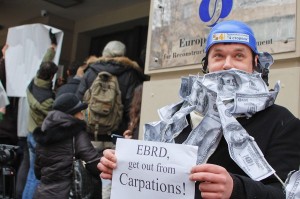 Appeal of Ukrainian environmental NGO the European Bank for Reconstruction and Development (EBRD)
Appeal of Ukrainian environmental NGO the European Bank for Reconstruction and Development (EBRD)
not to lower bank’s standards in the field of biodiversity conservation
Prepared within the process of consultation on draft EBRD Environmental and Social Policy (ESP)
5 March 2014
We, the representatives of Ukrainian environmental NGOs, are concerned with draft revised EBRD Environmental and Social Policy (ESP) introducing a number of changes that effectively lower bank’s requirements in the field of biodiversity conservation and protection of valuable natural areas from human intervention.
In Ukraine, as in most of bank’s countries of operations, there are very few natural areas left (semi-natural territories cover about 20%, unmodified natural – less than 2%) and the utmost should be done to prevent the loss of that little we still have. The EBRD’s general approach to dealing with the environment – environmental ‘management’ rather than environmental protection- does not help in this task. Clarification and extension of this approach in the new ESP draft could inspire more projects potentially negatively impacting natural sites, including vulnerable areas and habitats of vulnerable species.
Our comments and proposals of changes to the text of PR6 and other relevant places in EBRD ESP can be found below.
Weakening of PR 6 on biodiversity conservation (ESP)
The previous Performance Requirements on biodiversity conservation and sustainable management of living resources (PR6) needed to be strengthened by binding commitments on behalf of the EBRD to ensure compliance of financed projects with EU law and standards. However, this has not happened. Moreover, a number of changes suggest a significant weakening of biodiversity safeguards, lowering even the ambitions of the goals, for example:
The objectives of biodiversity conservation and sustainable management of living natural resources must be balanced with the potential for utilising the multiple economic, social and cultural values of biodiversity and living natural resources in an optimised manner;
We believe that such formulation of objective implies that biodiversity loses may be considered by the bank as acceptable in certain cases, threatening effective implementation of environmental protection objectives. In Ukrainian realities such formulation would give “green light” to investors for developing projects in areas of potential conflict between nature conservation values and economic values of biodiversity or other natural resources. Following the adoption of the law of Ukraine on “green tariff” and the setting up of specialized lending facilities (like EBRD USELF) new companies started to emerge in Ukraine whose activities are focused on the use of these opportunities (like LLC Hydropower). It is therefore very important that the EBRD ESP clearly sets the frame/limits beyond which infrastructure projects will not be considered by the bank in order not to provoke development and to not lose efforts on the development and review of projects that may have adverse effects on biodiversity and will in the end be unacceptable. These new power generating companies are purely profit-driven, and they strive to get the cheapest available lands which are those that are in state property and not in use. Considering high percentage of land reclamation in Ukraine these remaining pieces of untouched lands are often valuable natural territories, crucial for conservation of vulnerable species that are yet to obtain protective status.
The objective is “no net loss of biodiversity”;
This suggests an acceptance of the notoriously unreliable idea of ‘biodiversity offsetting’ in which the destruction of one area or habitat is ‘compensated’ by attempting to increase biodiversity somewhere else. We are absolutely against such approach – artificial ecosystem cannot fully compensate for the lost values of natural ecosystem. Therefore, effective stopping of biodiversity lose is only possible through preservation of existing natural ecosystems. The objective of PR6 therefore should be no lose of biodiversity and natural habitats.
“Where the project occurs within or has the potential to adversely affect an area that is legally protected or internationally recognised or designated for protection, the client must identify and assess potential project – related impacts and apply the mitigation hierarchy so as to prevent or mitigate impacts from projects that could compromise the integrity, conservation objectives or biodiversity importance of such an area.”
The mitigation hierarchy – avoid / minimise / mitigate / offset – confirms the EBRD’s approach that there are no no-go zones, no impact that cannot be managed and should thus prevent an investment proposal. In our opinion, however, there are simply some investments in some locations that should not take place, and criteria should be set up in the way to reject projects that are destructive to natural ecosystems and threatening biodiversity loses.
It is not clear what happens if the status of a protected areas does not allow for mitigation, eg. according to national law some protected areas are out of reach for industrial activities, although the implementation of this law can be weak. Also the requirements for ‘due process’ are deleted, raising questions about the permitting procedures and the public participation in deciding on these measures.
Also PR6 allows for implementing destructive projects in critical habitats if a number of criteria are satisfied, however it is not clear whether all of these criteria must be satisfied or just one or two of them. If the latter, then the criterion that “no other viable alternatives within the region exist for development of the project in habitats of lesser biodiversity value” is worrying. In the case of underground resources where project siting cannot have alternatives, this new condition is the exact opposite to environmental NGOs demand for no-go zones. But this condition will be applied to projects in other sectors as well, eg. for hydro-power, as long as there are “no technically and economically feasible alternatives” which clients will almost always argue is the case;
Paragraph 8 and paragraph 10 of PR6 practically lower the quality of the ESIA of the project required from the clients. According to paragraph 8 “in planning and implementing biodiversity related baseline and impact assessments clients will refer to relevant good practice guidance” and “where further investigations are needed to provide greater certainty of the significance of potential impacts, the client may carry out additional studies and/or monitoring before undertaking any project related activities,” meaning that instead of requiring the client to prepare a high quality ESIA report that assesses all potential impacts of the project beforehand (which would be considered as an added value of the Bank) the Bank just accepts an ESIA and, according to our experience, merely “review” it and may request some additional studies of certain potential impacts, or may not request. In some cases this additional studies are finalized after project’s approval, and in cases of unacceptable impacts being identified, it is difficult to cancel such project and procedure for cancellation is not described in ESP or, to our knowledge, elsewhere in bank’s document available to public.
Considering all of the above we ask you to introduce following changes into final draft of ESP:
In the text of the Performance Requirement 6:
1. The objective of PR6 must be protection and conservation of biodiversity. PR6 priority must be no loss of the existing natural habitats and no loss of biodiversity; 2. PR6 should define “no-go zones”, where any projects of categories A and B will not be considered. No go zones should cover IUCN categories I-IV and corresponding protected areas within national categorization systems, the areas with high conservation value/importance territories (eg. upstream of rivers, riparian floodplains, intact (virgin) forests, mountainous wetlands, habitats of rare and endangered species and subspecies).
3. PR6 should include requirement for the projects to comply with the EU Habitats Directive;
4. All studies of the significant impacts should be done within the scope of EIA before the final decision on project;
In the Project Requirement 10:
1. For category B projects, EIA reports prepared according to national requirements should be made
available on projects’ webpages on the official EBRD websites. Relevant proofs of client’s compliance with the requirements on public participation during the process of EIA should be also made available on projects’ webpages on the official EBRD website (for example, the list of links to the Statements of Intent and EIA reports on client’s webpage). This should be available for the review before final decision on project. For the projects within direct lending facilities such information should be made available on facility’s webpage.
There also should be information about the timing of the decision to be made;
2. Environmental and Social Action Plans (ESAP) for the category B projects should be made available to public upon request.
Organizations and people who endorse this appeal:
1. Yury Urbansky, National Ecological Center of Ukraine (NECU)
2. Oleksij Vasyliuk, Institute of zoology, National Academy of Science of Ukraine
3. Bohdan Prots, WWF
4. Anatoliy Pavelko, Danube-Carpathian program, WWF
5. Sergiy Fedorynchyk, information center of UEA “Zelenyj Svit”
6. Yena Andriy Vasyliovych, The National University of Life and Environmental Sciences of Ukraine
7. Burkovsky Oleksij Petrovych, All-Ukrainian Environmental Leagues, Donetsk region.
8. Kuzemko Anna Arkadiivna, European Dry Grassland Group, Uman
9. Petro Testov, Zelene Majbutne
10. Valerian Gordienko, Zelene Majbutne
11. Yury Lisovij, Zelene Majbutne
12. Volodymyr Jarotskiy, eco-touristic club “Pathfinders”, Kharkiv
13. Liubinska Liudmyla Grygorivna, Podilsk Naturalists Society, Kamenetz-Podolsky.
14. Valerij Lovchinski, GreenVideo, Kharkiv
15. Oleksandr Sokolenko, NECU Youth branch
16. Viktoria Ivanets, NECU Youth branch



